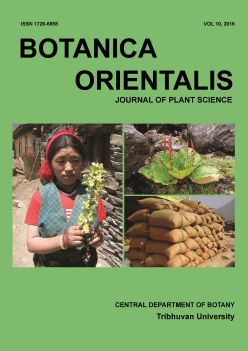Export of medicinal and aromatic plant materials from Nepal
DOI:
https://doi.org/10.3126/botor.v10i0.21020Keywords:
database, destination countries, Himalaya, MAP trade, trade value.Abstract
Medicinal and aromatic plants (MAPs) have been identified as one of the potential high value commodities in Nepal with huge prospects for economic development. However, data about MAP consumption, volumes of trade and levels of demand are inadequate. In Nepal, there is a general lack of reliable trade data that constrains the estimation of total amount of MAPs in trade. This study aims to assess current trends in volume and value of MAP commodities exported from Nepal and identify the major destination countries. We mainly used formal trade data of Nepalese MAP products over the last 10 years (2005 to 2014) from the repository of UN COMTRADE database accessed via TRADE MAP. Results indicated that the export value of MAP products increased from USD 27.49 million in 2005 to USD 60.09 million in 2014 (mean for the last 10 years being USD 39.34 million) and this increment is primarily due to increase in price, as the trade volume follows decreasing trend over the same periods. The average annual export amount of Nepalese MAP products for the last 10 years has been calculated to be 13.23 thousand tons (range 10.77–20.25 thousand tons). The rise in export value of MAP products indicates increasing demand of MAPs globally. Nepalese MAP commodities were exported to almost 50 destinations. In terms of volume, India has been the major importer of MAP materials all these years. However, China stood top among the countries sharing high value to Nepalese MAP trade. The trade statistics show that, for the total trade value considering the MAP materials at broad category, the export of products (e.g., spices and flavors) other than listed in HS code 1211 should also be considered for appropriate valuation. Despite the decrease in trade amount, spices and flavors have fetched a gradually increasing price per unit volume which is apparent by the fact that these herbs have ever increasing market demand. Nepal can reap maximum benefit from growing international demand of MAPs given that Government impose strict check in borders to minimize the underestimation, train concerned authorities in proper identification of MAPs products and help to develop species-specific 8- and 10-digit HS Codes for proper documentation of imports and exports of MAPs products.
Botanica Orientalis – Journal of Plant Science (2016) 10: 24–32
Downloads
Downloads
Published
How to Cite
Issue
Section
License
This license enables reusers to copy and distribute the material in any medium or format in unadapted form only, for noncommercial purposes only, and only so long as attribution is given to the creator.




